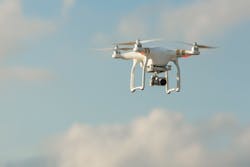While security incidents involving the use of drones have been well-documented in recent years, from numerous close encounters with commercial airliners to radioactive sand being flown onto the roof of the Japanese prime minister’s home, many have considered the threats posed by these unmanned aerial vehicles to be minimal. However, some of the worse-case scenarios previously discussed in hypothetical terms by experts have now started to come to fruition.
Just this month, a drone outfitted with explosives was used by ISIS fighters in Iraq to kill two Kurdish soldiers and wound two French commandos. If using UAVs as instruments of terror wasn’t bad enough, it appears that ISIS and other groups in the region also intend to leverage the video gathering capabilities of the technology for propaganda purposes. In fact, the Taliban recently used a drone to record the suicide bombing of a police station in Helmand Province.
To prevent would-be terrorists from using drones to carry out or film an attack against this year’s presidential nominees, federal and local public safety authorities in Las Vegas deployed SpotterRF’s drone detection technology during last week’s presidential debate. The company’s A2000 CSR radar solution was used in conjunction with Milestone Systems' video management software and the NMS SpotterXP plugin to secure the air and ground perimeter around the UNLV Thomas & Mack Center where the debate took place.
According to SpotterRF CEO Logan Harris, the use of the company’s technology at such a high-profile event show that the dangers presented by drones in the wrong hands are something that people can no longer ignore.
“We’ve been doing counter drone work for some time at shorter ranges with, for instance, our C550 model that we released back in 2014. It can pick up one of these small drones at around 350 to 400 meters away from the radar system. Just recently we released the A2000 at ASIS that has a 1,000-meter range so it is becoming more of a problem as there is very large adoption of drone technology across the world – both hobbyists as well as groups that are using this technology in ways that can be harmful to people and critical infrastructure,” Harris explains.
During the debate, Harris said the A2000 was mounted on a portable light pole generator along with several surveillance cameras and communicated wirelessly back to a Milestone server housed within an operations center. SpotterRF’s radar maps were integrated with the Milestone client using the SpotterXP plugin from NMS, which enabled authorities to view video streams and objects on radar in real-time.
“The SpotterXP plugin gives the operators using Milestone; they just have one software package they need to access to see all of their cameras as well as to get more information from the Spotter feed,” he says. “They can see the [object tracking] and the video at the same time and also do things like go back and look at the history so they can review back through time and see what was happening on the tracks as well as video, so it makes it easier for them to do forensics and manage these types of devices.”
Although they tracked a number of different aerial vehicles, Harris says no threatening airborne targets appeared on the radar during the debate. Still, having the capability to detect an UAV and take action well in advance of its arrival in the area would have been paramount.
“The main things we look at as we’re implementing a system to detect drones is being able to discriminate other targets – birds, planes in terms of what is in the air and also if you are picking things from the ground – and that’s why our system is particularly well-suited for tracking these small drones,” he adds. “We can position them so that they are looking up into the sky and not picking up all of the motion on the ground and that is something that sets us apart from other radar systems that are made to see at longer ranges, higher speeds and greater altitudes. We can take a small radar system, move it down on the facility itself looking up into the sky and just pickup smaller airborne targets.”
SpotterRF’s drone detection technology was not the only one used during the debate. The Las Vegas Metropolitan Police Department also deployed Dedrone’s counter-drone solution to detect and identify airborne threats during the event.
In a statement, Dedrone said it provided automated monitoring of the airspace above the university along with its partner AirVu. The companies used a network of multi-sensor DroneTrackers to detect and identify drone incursions in a radius of several hundred meters from the debate location, extending beyond the campus perimeter.
“Even though Las Vegas has hosted heads of state and presidents, the presidential debate coupled with the large crowd that it drew, posed a unique set of risks,” LVMPD Assistant Sheriff Tom Roberts says. “We were able to seamlessly integrate the tracker into our safety plan. Having technology that will protect us from the air and provide real-time information was a huge advantage to having a safe and uneventful evening.”
Although he cannot mention them by name, Harris says that SpotterRF has already been selected to help spot and track drones at other high-profile events in the future and that a deployment like the one at the presidential debate will help raise the profile of the technology moving forward.
“It does point out that this is a real concern at this time as people look at what they need to do to in order to protect the safety of the people who are at a venue or at a facility and that drones are something that have to be considered as part of the overall security plan,” Logan says. “They can no longer be ignored because of the threats they pose.”



